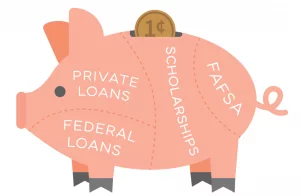When I was in high school, if you asked me the difference between a scholarship and a loan, I could most likely tell you that. However, any more detailed talk of the various forms of financial aid/paying for school definitely got me confused.
Now, I want you all to learn from my mistakes! I think it is super important (and I want to ensure) that YOU are fully knowledgeable and aware of all the options and resources that you have at your disposal.
If you’re reading this and you are currently enrolled in college or grad school, you may be thinking, how is this even relevant to me if I’m already there?!
My answer for you is, learning more about the different ways you can fund your education is crucial, no matter what stage in the process you’re at. Maybe you’re a freshman or a sophomore in college, and you’ll learn something that might cause you to rethink your financial strategy going forward.
So, without further ado, here is my quick guide on all of the ways you can pay for college.


Scholarships, also known as grants, are awards that you can receive on the basis of merit (academic performance), financial need, or other components.
Money that you earn from scholarships can be a real game-changer because that money does not ever need to be repaid. So, once you’ve earned it, it’s yours to put towards paying for college.
Thousands of private organizations and businesses (think: Coca-Cola, McDonald's, and Google on a large scale) offer scholarship opportunities for students to apply for.
Applying for private scholarships can be a great way to earn some extra cash to help you pay for school. These scholarships can range from a few hundred dollars to full-ride opportunities, so definitely don’t underestimate the potential earnings here.
If you’re just starting out in the scholarships world and you have little or no idea where to start, luckily for you, I have tons of blog posts to highlight scholarships in different categories, such as no essay scholarships, STEM scholarships, and scholarships for women. Head to my blog to check out more posts like these!
There are several scholarships and grants that you might automatically be eligible for receiving when you file your FAFSA each year, such as the Federal Pell Grant.
If you’re in high school, then in addition to being considered for federal grants through the FAFSA process, you will also find out once you hear back from the colleges you’ve applied to about whether or not you have qualified for any of their specific scholarships.
It is super important to make sure your FAFSA gets submitted as early as possible (well before the final FAFSA deadline!), to ensure that you receive all of the aid that you are potentially eligible for.
College-specific scholarships often take into account your standardized test scores, grade point average, and other components of your academic performance. These scholarships can range from a few thousand dollars each year to $20,000+ per year (some students might even qualify for a full-ride!).
If you’re still in the process of looking at schools or even applying for college and you are trying to be as cost-efficient as possible (who isn’t?!) I recommend you do some research on the approximate costs of each school that you are interested in attending.
Each school likely has what’s called a net price calculator on their website somewhere (probably in the financial aid section) that will allow you to calculate a more accurate overall cost after scholarships and grants are subtracted from the equation.
Most US colleges and universities participate in what is called federal work-study programs.
These programs provide part-time jobs (on and off campus) to both undergrads and grads who have financial need. The cool thing about federal work-study programs is that they encourage students to pursue part-time employment in an area that is related to their area of study, while also giving them an extra way to pay for college.
With federal work-study, you're guaranteed to earn at least the federal minimum wage in any job you hold, however, you can definitely be paid more depending on your experience and level of financial need.
Income from any part-time jobs or internships you might secure near campus or over the summer break will most likely not be enough to fully cover your college costs (especially due to the fact that college costs are rising to crazy high amounts these days).
However, it can certainly be a great help in covering some of the additional expenses that you will probably encounter during your time in school, such as textbooks, supplies, technology, etc. As a bonus, work experience can be a great way to help prepare you for the "real world" and give you a better idea of what you're interested in pursuing for a career!
Throughout my four years of college, I was able to make some extra cash mostly through summer internships, but I also had a part-time job at an event center one semester that was helpful for offsetting some of the costs for my following semester abroad.
If you’re interested in working a part-time job during the school year, I highly recommend you head over to your school’s online job board (most universities have them) and check out some of the options that might be open and available near you.
If you’re looking for internship opportunities, I suggest creating an account on LinkedIn (if you don’t have one already) and looking at the internships (summer, winter, and spring) that many companies have for students.
I also recently released an eBook designed to walk you through all the steps of creating a LinkedIn profile, resume, and cover letter to apply for jobs and internships, which you can download here!
A great option for families to take advantage of when it comes to saving money for college is the 529 plan. 529 plans are beneficial because they “provide tax-free growth and tax-free withdrawals for qualified education expenses, such as tuition, room, board, fees, and books”.
Despite all of their benefits, surveys show that back in 2017, only roughly 17% of students under the age of 18 had 529 plans. If you’re prepping for college and haven’t already had the financing college conversation with your family members or other relevant people, I suggest you do so ASAP, and ask them if you have a 529!
Even if you don’t have a 529 plan, family savings and income are a common method of paying some of the costs of college or graduate school. If you have the means to pay off any of your higher ed costs through yours or your family’s income, it is a better alternative to taking out loans that have to be repaid with interest.
Due to the unfortunate fact that any money you borrow through loans to pay for college needs to be paid back (with interest), I have placed loans at the way bottom of the hierarchy here.
Despite their place in the hierarchy, loans are, for the majority of students, an essential piece of the paying for college puzzle, especially because not everyone can earn thousands of dollars through grants and scholarships! Once you graduate, it may be wise to consolidate you loans. Use this handy student loan consolidation calculator to estimate if it's right for you!
To start, the federal government offers a few different student loan options to help you pay for college. If you file the FAFSA (which you ABSOLUTELY SHOULD!!), you will probably find that your financial aid package will include loans that you are qualified to receive.
There are a few different types of federal loans, and to be honest, no one can outline them all better than the Student Aid website itself. So, head over to the Student Aid website if you want to learn more about the different types of federal loans that are available.
The amount that you're eligible to receive through federal loans varies depending on your level of financial need, the type of degree you are going for, your dependency status, and other factors, which all eventually come together through a (complicated) formula to give you an EFC (Expected Family Contribution).
When you take out money through federal loans to pay for college, you do not need to start paying back the money you borrowed until you graduate or drop down to below part-time enrollment.
The other common form of loan that you might take out to help you pay for college is private loans.
You should only really revert to applying for private student loans if you have maxed out in terms of what you are able to receive through federal loans and you still have outstanding college costs that cannot be covered through any of the other aforementioned methods.
One thing to note about private loans is that they often have fewer benefits for students than federal loans, which usually have lower interest rates and the possibility for student loan forgiveness down the line.
So, if you have to go down the path of taking out loans, which is totally normal, consider federal loans before private. If you have already taken out loans and are looking to trim your payments, you may want to conserve a private student loan consolidation.
Although it is not considered an actual method of paying for school, another strategy that is becoming increasingly popular (especially amid this pandemic) is students enrolling in community college for a year or two and later on transferring to a four-year college or university.
The benefits of doing this can be huge. Oftentimes at a traditional four-year college or university, the majority of your first and even second years can consist of those “gen-ed” classes that all students have to take.
If you are looking to be cost-conscious, the general consensus is that it really doesn’t matter if you take those general classes at a community college and later on transfer to a four-year college or university to finish out your degree. So, if you’re in high school and you’re worried about paying for your higher education, consider looking into this as an option for reducing some of those costs.
This “quick guide” ended up being longer than I intended but at the end of the day, I hope you have found it helpful in terms of highlighting all the ways you can pay for college.